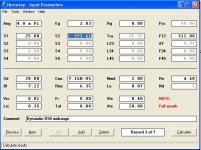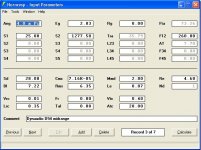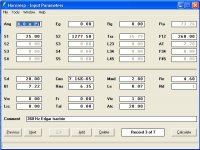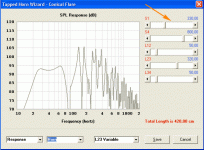Hi Jean-Michel,
Thanks for your comments.
You are correct - I changed the procedure so that a phase inversion discontinuity could never occur when the offset delay correction slider was moved from 0.0 msec (standard wrapped phase) to 0.1 msec (corrected phase). The modification was implemented because a number of users had asked me why the Hornresp corrected phase results did not become identical to the standard wrapped phase results when the offset delay correction value was set to zero using the Delay tool. Unfortunately it seems that my modification has had some undesirable side-effects. I will give it further thought, but I suspect that it may be better to revert to the original code and just accept that sometimes there will be a phase inversion when the delay is changed from zero to non-zero.
The phase response display problem reported by Oliver (tb46) in Post #2286 was due to an error on my part - I had incorrectly translated one line of your Matlab phase unwrapping code. This was rectified in Product Number 2870-111015.
Kind regards,
David
Thanks for your comments.
I remember to have introduced in the code of the phase/delay module of Hornresp a test which check the polarity. When a polarity inversion is detected then a phase inversion is performed. Seems that this procedure is fooled in the last version.
You are correct - I changed the procedure so that a phase inversion discontinuity could never occur when the offset delay correction slider was moved from 0.0 msec (standard wrapped phase) to 0.1 msec (corrected phase). The modification was implemented because a number of users had asked me why the Hornresp corrected phase results did not become identical to the standard wrapped phase results when the offset delay correction value was set to zero using the Delay tool. Unfortunately it seems that my modification has had some undesirable side-effects. I will give it further thought, but I suspect that it may be better to revert to the original code and just accept that sometimes there will be a phase inversion when the delay is changed from zero to non-zero.
Also, some previously mentionned phase problems may occur when both a front and a rear wave interfer. If an inverse polarity for the front wave is detected then the phase inversion should be applied to both the front wave and the rear wave.
The phase response display problem reported by Oliver (tb46) in Post #2286 was due to an error on my part - I had incorrectly translated one line of your Matlab phase unwrapping code. This was rectified in Product Number 2870-111015.
Kind regards,
David
Inputs below.
Thanks littlemike.
See my post above to Jean-Michel for an explanation of the cause of the problem.
One way or another, I will do something about it for the next release.
Kind regards,
David
I have a Bruce Edgar tractrix horn made for a Dynaudio D54 driver from 20 years ago. I'm trying to model it in Hornresp. I've used the datasheet for the D54 driver to model the horn, but it sure does look bad in the SPL simulation. The directivity is horrible as well, being omnidirectional below about 1 KHz and becoming more and more directive above that. I've attached the input screen I used. What I did was enter the driver data, then use the system designer to make a 311 Hz full size horn. I'm pretty sure this Bruce Edgar horn is actually a 300 Hz tractrix, but intended for 500Hz to 5KHz response. So, I changed the throat size to the 25 sq cm since I know that the throat is 2" square for the 2" D54. There is no throat adapter. It's a round dome stuck in a square hole. I've used my TrueRTA software real time analyzer and on axis the response looks good but I didn't do much more with it at the time. I'm wondering how I can improve this horn system. Should I make a throat adapter? Should I get a different driver, like a 2" compression driver? Should I just toss all of it and start over? Ideally, I'd like constant directivity over the pass band of 500Hz to 5KHz, if possible. I guess I should measure the horn better to see if there's another driver that would give better results.
Attachments
Last edited:
For constant directivity over that range, look at an OS flair. You'll also need a larger mouth as you've found out to get the pattern control at low frequencies. However what might be a better idea would be figuring out the necessary mouth size to match the directivity of the horn to whatever driver or horn you'll use to reproduce the frequency band below this horn. If you're using a direct radiator, the mouth should be around the same size as the driver's cone.
I dug out the horns and measured them and put the parameters into Hornresp. It's actually about a 260Hz horn. The results are still terrible. Should I look for a different driver? What features would I look for if I wanted to do replace the D54 with something else? I'm not sure the T/S parameters are much use for midrange and higher frequency horn drivers, since I have read that at these frequencies the suspension dominates the response, as Bruce talked about in his article.
Attachments
For constant directivity over that range, look at an OS flair. You'll also need a larger mouth as you've found out to get the pattern control at low frequencies. However what might be a better idea would be figuring out the necessary mouth size to match the directivity of the horn to whatever driver or horn you'll use to reproduce the frequency band below this horn. If you're using a direct radiator, the mouth should be around the same size as the driver's cone.
OK, this horn should match up pretty well to a 15" woofer for the lower frequencies, based on the measurements I took of the horn.
What is an "OS" flair? do you mean "flare"... ?
Last edited:
How do you figure out the ideal driver for a given horn? I'd like to know if there are better drivers out there for this Edgar horn I have.
I guess I can work backwards for the throat area.
St=0.8*Fs*Qes*Vas
I have St = 4
So, I need a driver that has Fs*Qes*Vas = 5.
This one:
http://www.parts-express.com/pe/showdetl.cfm?Partnumber=264-889
is 5.77... Hmmm...Tang Band 4"
This one:
http://www.parts-express.com/pe/showdetl.cfm?Partnumber=264-890
is 4.64.... Huh, go figure. another TB 4".
This one:
http://www.parts-express.com/pe/showdetl.cfm?Partnumber=294-651
is 6.37... 6.5" B&C midrange. Another B&C midrange:
http://www.parts-express.com/pe/showdetl.cfm?Partnumber=294-646
is 5.80
am I on the right track? Does Hornresp have a feature where you can take a given horn and find the perfect driver for it?
I guess I can work backwards for the throat area.
St=0.8*Fs*Qes*Vas
I have St = 4
So, I need a driver that has Fs*Qes*Vas = 5.
This one:
http://www.parts-express.com/pe/showdetl.cfm?Partnumber=264-889
is 5.77... Hmmm...Tang Band 4"
This one:
http://www.parts-express.com/pe/showdetl.cfm?Partnumber=264-890
is 4.64.... Huh, go figure. another TB 4".
This one:
http://www.parts-express.com/pe/showdetl.cfm?Partnumber=294-651
is 6.37... 6.5" B&C midrange. Another B&C midrange:
http://www.parts-express.com/pe/showdetl.cfm?Partnumber=294-646
is 5.80
am I on the right track? Does Hornresp have a feature where you can take a given horn and find the perfect driver for it?
Last edited:
Hi littlemike,
The Hornresp corrected phase response has been changed back to the original format. Product Number 2870-111027 refers. My thanks to Jean-Michel and yourself for helping me to clarify my thinking on this matter.
Kind regards,
David
One way or another, I will do something about it for the next release.
The Hornresp corrected phase response has been changed back to the original format. Product Number 2870-111027 refers. My thanks to Jean-Michel and yourself for helping me to clarify my thinking on this matter.
Kind regards,
David
Last edited:
What is an "OS" flair? do you mean "flare"... ?
Hi dirkwright,
John is suggesting that you may wish to consider using an oblate spheroidal waveguide rather than a tractrix horn, if constant directivity is an important requirement.
Kind regards,
David
Does Hornresp have a feature where you can take a given horn and find the perfect driver for it?
Hi dirkwright,
Not really.
The closest would be Tools > System Design > From Specifications...
The tool can be accessed from the main input parameters window when in edit mode.
Kind regards,
David
Hi littlemike,
The Hornresp corrected phase response has been changed back to the original format. Product Number 2870-111027 refers. My thanks to Jean-Michel and yourself for helping me to clarify my thinking on this matter.
Kind regards,
David
Many thanks for all your efforts, they are much appreciated.
Things seem to be working properly with the latest revision.
Hi dirkwright,
John is suggesting that you may wish to consider using an oblate spheroidal waveguide rather than a tractrix horn, if constant directivity is an important requirement.
Kind regards,
David
OK, thanks. How do you design an oblate spheroid wave guide?
OK, thanks. How do you design an oblate spheroid wave guide?
 Carefully
Carefully Keystrokes:
T for tractrix
L for Le Cléac'h
O for oblate spheroid
Carefully
Keystrokes:
T for tractrix
L for Le Cléac'h
O for oblate spheroid
Oh! well duh! Thanks! Cheers

So basically, the consensus is to toss this Edgar tractrix horn and start over? Jeez, I hate to do that. I'd rather find a better driver for it, or modify it somehow, or both.
I assume that compression drivers cannot be modeled in Hornresp since their T/S parameters are generally unknown, is that right? Also, how can someone predict the response of putting a particular compression driver on a particular horn? Would I just look at the FR provided by the manufacturer and assume that the horn + the driver would be the same or similar?
Last edited:
Hello,
One tip to design the horn for a driver having unknown parameters is to use a constant velocity source ( = perfect driver) which is obtained in Hornresp replacing Eg = 2.83V by 0.
Best regards from Paris, France
Jean-Michel Le Cléac'h
One tip to design the horn for a driver having unknown parameters is to use a constant velocity source ( = perfect driver) which is obtained in Hornresp replacing Eg = 2.83V by 0.
Best regards from Paris, France
Jean-Michel Le Cléac'h
Oh! well duh! Thanks! Cheers
I assume that compression drivers cannot be modeled in Hornresp since their T/S parameters are generally unknown, is that right? Also, how can someone predict the response of putting a particular compression driver on a particular horn? Would I just look at the FR provided by the manufacturer and assume that the horn + the driver would be the same or similar?
Hello,
One tip to design the horn for a driver having unknown parameters is to use a constant velocity source ( = perfect driver) which is obtained in Hornresp replacing Eg = 2.83V by 0.
Best regards from Paris, France
Jean-Michel Le Cléac'h
Thanks. I think I'll do some actual measurements on the horn and driver I've got before doing anything else. I did a brief real time analysis using TrueRTA and it looked good from 500 to 5KHz.
http://www.diyaudio.com/forums/atta...8919-hornresp-dynaudio-d54-corrected-horn.jpg
Hmm, haven't actually compared measured to simmed, but seems to me that when simming a sealed back driver that Vrc/Lrc should be left blank since the rear chamber's affect on the driver's T/S specs has already been accounted for.
GM
Hmm, haven't actually compared measured to simmed, but seems to me that when simming a sealed back driver that Vrc/Lrc should be left blank since the rear chamber's affect on the driver's T/S specs has already been accounted for.
GM
http://www.diyaudio.com/forums/atta...8919-hornresp-dynaudio-d54-corrected-horn.jpg
Hmm, haven't actually compared measured to simmed, but seems to me that when simming a sealed back driver that Vrc/Lrc should be left blank since the rear chamber's affect on the driver's T/S specs has already been accounted for.
GM
Thanks! That makes a huge difference. It's more in line with what I measured now.
Attachments
- Home
- Loudspeakers
- Subwoofers
- Hornresp



